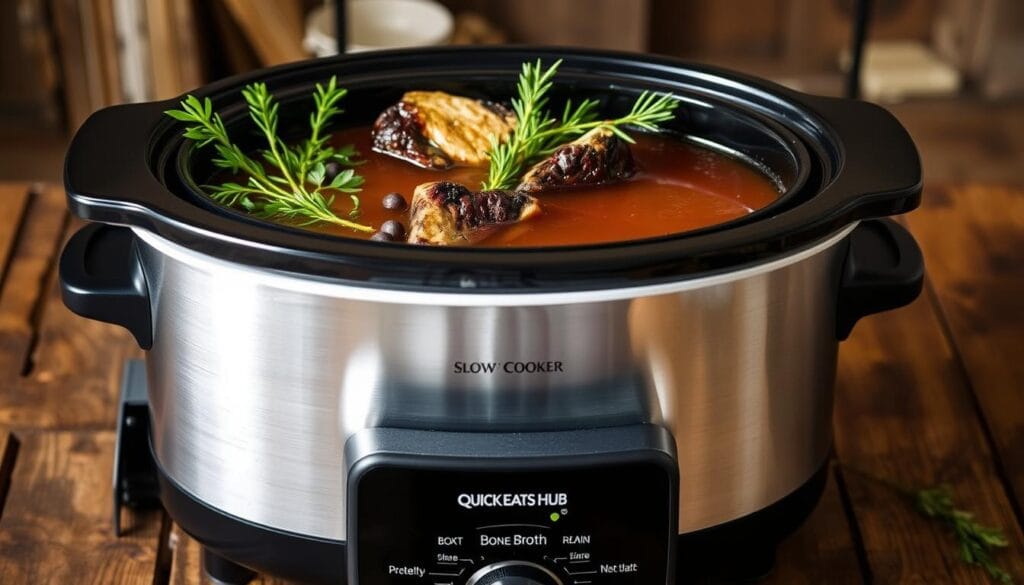Imagine sipping on a warm, comforting cup of homemade bone broth, packed with nutrients and made effortlessly in your slow cooker. This isn’t just another recipe—it’s a game-changer for your health and your kitchen. By using a slow cooker, you can enjoy a hands-off, time-efficient way to create a delicious and nutritious broth that surpasses anything store-bought.
Why make Bone Broth in a Slow Cooker at home? For starters, it’s incredibly rich in calcium, collagen, and amino acids—essentials your body craves. The slow cooker method ensures you extract every bit of flavor and nutrition from your ingredients, making it a simple yet powerful addition to your daily routine.
With this recipe, you’ll learn how to:
- Select the best ingredients for maximum nutrition
- Master the step-by-step slow cooker process
- Store your broth for freshness and convenience
Ready to get started? Let’s dive into the details and make your homemade bone broth journey as easy as possible.
Table of Contents
Understanding the Benefits of Bone Broth
Discover how this nutrient-dense liquid can transform your health. Bone broth is more than just a tasty base for soups; it’s a powerhouse of nutrition that has been cherished for centuries.
Nutrient Highlights for Your Health
What makes bone broth so special? It’s packed with collagen, amino acids, and essential minerals. These nutrients are vital for healthy skin, joints, and digestion. The slow cooking process ensures that every beneficial compound is extracted, making it a natural source of energy and wellness.
| Nutrient | Homemade Bone Broth | Store-Bought Broth |
|---|---|---|
| Collagen | High levels, promoting skin and joint health | Often lower, may lack gelatin |
| Amino Acids | Rich in glycine and proline | Varies by brand, may be limited |
| Minerals | Abundant in calcium, magnesium, and phosphorus | Generally lower mineral content |
Healing Properties and Gut Support
The natural gelatin in bone broth acts like a soothing balm for your intestines. This makes it a great choice for anyone with digestive issues. Studies suggest that the amino acids in bone broth may even reduce inflammation and protect the gut lining.
By simmering bones for several hours, you release all the hidden nutrients. This traditional method has been used for generations to nourish and heal. Plus, with no unwanted additives, you can feel good about what you’re putting in your body.
Essential Ingredients and Tools
Creating a nutrient-packed broth starts with the right ingredients and tools. Quality matters, so choose fresh, organic vegetables and source your bones from grass-fed animals for maximum nutrient density.
Stocking Your Kitchen for Success
Your stockpile should include carrots, celery, and onions for added flavor and nutrients. Apple cider vinegar or lemon juice helps draw minerals from the bones, enhancing the broth’s nutrient profile.
Fresh vegetables aren’t just for flavor; they add vitamins and minerals. Consider saving vegetable scraps and leftover bones to keep your broth affordable and sustainable.
Choosing a Reliable Slow Cooker
A slow cooker is your best tool for hands-off cooking. It extracts flavors and nutrients over time, ensuring a rich broth. Pair it with a fine-mesh strainer for a smooth finish.
Slow cookers offer convenience and consistency, making them ideal for this recipe.
Preparing Your Bones and Vegetables
Starting with fresh, high-quality ingredients is key to a delicious and nutritious broth. Let’s break down how to prepare your bones and vegetables for the best results.
Selecting the Best Bones and Vegetables
Choose bones from grass-fed animals like chicken, beef, or lamb for higher nutrient content. These bones are rich in collagen and minerals. For vegetables, opt for carrots, celery, and onions—they add natural sweetness and depth to your broth.
Proper Cleaning and Cutting Techniques
Clean and trim the bones to remove any impurities. This step ensures a clear broth.Chop the vegetables into large piecesto maximize their surface area, which helps release more flavors and nutrients during simmering. Consider roasting the bones beforehand for enhanced flavor—a tip many cooks swear by for a richer broth.
By carefully selecting and preparing your ingredients, you set the stage for a broth that’s both flavorful and packed with nutrients. This attention to detail makes all the difference in the final result.
How to Make Bone Broth in a Slow Cooker Recipe
Transform your kitchen into a wellness haven with this simple, nutrient-rich recipe. Making homemade broth in a slow cooker is a breeze, and the result is a delicious, healthy addition to your meals.
Step-by-Step Cooking Process
Start by placing your prepared bones and vegetables into the slow cooker. Add 2 tablespoons of apple cider vinegar and a teaspoon of salt to enhance the extraction of minerals and flavors.
Next, pour in 8 cups of filtered water, ensuring all ingredients are submerged. Set your slow cooker to low heat and let it simmer for 12 to 24 hours. This extended cooking time is crucial for releasing the maximum amount of nutrients from the bones and vegetables.
Simmering, Straining, and Finishing Touches
After the simmering process, carefully pour the mixture into a large container using a fine-mesh strainer to remove the bones and vegetable remnants. Discard the solids and let the liquid cool slightly.
Once cooled, refrigerate the broth to allow the fat layer to solidify on top. Skim this layer off for a leaner broth, but be sure to retain the nutritious liquid beneath. This step ensures a clear, flavorful result without unnecessary fat.

This straightforward recipe is not only economical but also versatile, making it perfect for soups, sauces, or sipping on its own. Enjoy the benefits of a homemade, nutrient-packed broth with minimal effort and maximum flavor.
Incorporating Apple Cider Vinegar and Seasonings
Apple cider vinegar and seasonings play a crucial role in enhancing both the flavor and nutritional value of your homemade chicken bone broth. These ingredients not only elevate the taste but also ensure a more efficient extraction of nutrients from the bones.
The Role of Apple Cider Vinegar in Extraction
Apple cider vinegar is a key ingredient in your slow cooker chicken bone broth. It contains acetic acid, which helps break down the bone matrix, releasing essential minerals like calcium and magnesium. This process makes these nutrients more bioavailable, ensuring your broth is rich in collagen and amino acids. Studies suggest that adding 2-3 tablespoons of apple cider vinegar early in the cooking process significantly enhances mineral extraction.
Flavor Enhancers and Salt Adjustments
While apple cider vinegar boosts nutrient extraction, the right balance of salt and seasonings is essential for a delicious and healthy broth. Start with a light hand when adding salt, as you can always adjust to taste. Herbs like garlic, bay leaves, and peppercorns add depth without introducing unwanted additives. A note for flexibility: experiment with different herbs to find your perfect blend, ensuring the broth aligns with your dietary preferences.
Remember, slight variations in vinegar levels can impact both flavor and nutrient content. For example, using a bit more vinegar can enhance the broth’s clarity and mineral profile, while too little might result in a less flavorful broth. Finding the right balance is key to achieving a nutritious and tasty slow cooker chicken bone broth.
Customization and Variations for Your Broth
Once you’ve mastered the basic recipe, it’s time to make it your own. Your slow cooker chicken bone broth is a canvas waiting for your personal touch. Whether you’re experimenting with flavors or adapting to dietary needs, customization is key to creating a broth that suits your taste preferences.
Adapting the Recipe to Your Taste
One of the joys of making bone broth is the flexibility it offers. You can tailor every aspect of the recipe to match your preferences and what’s available in your kitchen. Here are some ideas to get you started:
- Add Your Favorite Vegetables: Carrots, celery, and onions are classics, but feel free to experiment with garlic, leeks, or even sweet potatoes for added depth.
- Herbs and Spices: Bay leaves, peppercorns, and thyme are staples, but you can also try cinnamon, ginger, or turmeric for a unique twist.
- Cooking Time Adjustments: Simmer for 12 hours for a lighter broth or go up to 24 hours for a richer, more intense flavor.
These small tweaks can transform your broth into a one-of-a-kind creation that reflects your culinary style.
| Customization Option | How to Implement | Result |
|---|---|---|
| Additional Vegetables | Add chopped mushrooms, zucchini, or bell peppers during the last 4 hours of cooking. | A vibrant, nutrient-rich broth with extra flavor. |
| Herb Infusions | Stir in fresh parsley, dill, or cilantro in the final 30 minutes. | A fresh, aromatic broth perfect for sipping or soups. |
| Spice Blends | Mix in a teaspoon of cumin, paprika, or chili flakes midway through cooking. | A bold, savory broth with a spicy kick. |
Remember, the key to customization is experimentation. Don’t be afraid to try new ingredients or adjust cooking times until you find your perfect blend.

Whether you’re sipping it straight, using it as a soup base, or incorporating it into sauces, your homemade broth is a versatile foundation for countless dishes. Let your creativity shine and enjoy the process of making it uniquely yours!
Storing and Using Your Homemade Broth
Once you’ve crafted your delicious homemade broth, proper storage is key to maintaining its flavor and nutrients. Whether you prefer refrigerating or freezing, there are simple ways to keep your broth fresh and ready for use.
Tips for Refrigerating and Freezing
Cool your broth to room temperature to prevent condensation in containers. Pour it into airtight glass jars or freezer bags, leaving about an inch of space at the top for expansion. Refrigerated broth stays fresh for up to one week, while frozen batches can last up to six months.
When freezing, consider portioning the broth into ice cubes or smaller containers for convenience. To thaw, simply leave it overnight in the fridge or thaw quickly by submerging the container in cold water.
Creative Recipe Ideas and Uses
Your homemade broth is a versatile base for countless dishes. Use it as a foundation for hearty soups, gravies, or sauces. It also adds flavor to cooked grains or can be sipped on its own as a warm, comforting drink.
Experiment with herbs and spices to create unique variations that suit your taste. Whether you’re making a comforting soup or enhancing a sauce, your broth is a nutritious and delicious addition to any meal.
By making large batches and storing them properly, you’ll always have a healthy, economical option on hand. Enjoy the benefits of your homemade broth in every dish you create!
Conclusion
With just a few simple steps, you can create a nutritious and delicious broth at home. This slow cooker method makes it easy to extract maximum nutrients from your ingredients, ensuring a healthy and flavorful result every time.
Your homemade broth is packed with collagen, amino acids, and essential minerals like calcium and magnesium. These nutrients support healthy skin, joints, and digestion. The slow cooker’s gentle simmering process ensures every beneficial compound is extracted, making it a natural source of energy and wellness.
Experiment with your recipe by adding your favorite herbs or vegetables. For a richer flavor, try roasting the bones beforehand. Remember to use high-quality ingredients like grass-fed beef bones and fresh vegetables for the best results.
Store your broth in airtight containers and refrigerate or freeze it for later use. This convenient method allows you to enjoy your homemade broth anytime, whether as a warm drink or a base for soups and sauces.
Share your experiences and modifications with others. Your creativity and insights can inspire a community of homemade broth enthusiasts. Happy cooking!
FAQ
What are the key benefits of using apple cider vinegar in bone broth?
Can I use any type of bones for bone broth?
How long should I simmer the broth for optimal results?
What vegetables are best to add to bone broth?
How do I store homemade bone broth properly?
Can I customize the recipe to suit my diet?
Is bone broth suitable for all diets?
How do I prevent fat from forming on the surface?
Can I reuse the bones for another batch?
What’s the difference between stock and broth?
There are no reviews yet. Be the first one to write one.

